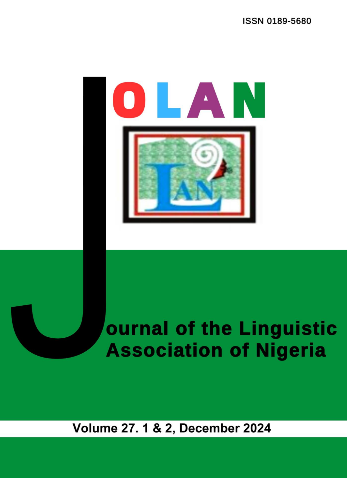Antonymy in Hausa Deaf Language
Keywords:
Relational Antonyms, Complementary Antonyms, Gradable Antonyms, Antonyms, Hausa Sign LanguageAbstract
Antonym is more concentrated on the oppositeness of word meaning. This would explain the existence of a large quantity of the vocabulary of spoken languages as well as in sign languages. Hausa deaf language is one of the sign languages which has quantity of lexical antonyms. It occurs via the change of hand movement, orientation as well as sign’s location in production. This article identifies and discusses lexical antonyms in the Hausa deaf language and shows the extreme function of parameters within their formation. Data were collected from deaf in various centres in the Kano metropolitan (Municipal, Fagge, Nassarawa, and Kumbotsu). The Hand Tiers Model initiated by Sandler (1989) was employed for the purpose of this analysis. The gradable, complementary, and relational
antonyms were all identified in the Hausa deaf language. The article identifies how the gradable antonyms are produced in the Hausa Sign Language which denotes degrees of variable property with intermediate or middle ground scale. The article also discusses
complementary antonyms in Hausa sign language. However, the article illustrates how the relational antonyms in Hausa sign language are formed.
References
Battison, R. (1978). Lexical borrowing in American Sign Language. Silver Spring: Linstok Press.
Cruse, D. (1986). Lexical semantics. Cambridge: Cambridge University Press.
Emananjo, E. (2015). A grammar of contemporary Igbo : Port Harcourt: M & J Grand Orbit Communications.
Gwammaja, I. (2009). Communication processes of Hausa deaf language. Postgraduate Diploma in Hausa Studies, Bayero University, Kano.
Gwammja, I. (2013) Articulators and parameters: A study of Hausa sign language. 1st National Conference, pp.159-167. Bayero University, Kano.
Gwammja, I. (2013). Articulators and parameters: A study of Hausa sign language. In L.
Yalwa, S. Gusa’u, H. Birniwa, M. Abdulƙadir, & Y. Chamo (Eds), Conference Center of Nigerian languages proceedings (pp.159-167). Bayero University Press.
Gwammaja, I. (2013) Hausa sign language classifiers. Harsunan Nigeriya CSNL 23, 54- 64.
Gwammaja, I. (2014). Language and gesture relationship: A morphological study of Hausa deaf language in Kano. M.A Thesis, Department of Nigerian Language and Linguistics. Bayero University Kano.
Gwammaja, I. (2015). Orientation as an ultimate parameter for the lexical sign in Hausa sign language. In O-Z. Ndimele (Ed), Language endangerment: Globalisation and fate of minority languages in Nigeria: A festschrift for AppoloniaUzoaku Okwudishu (pp. 347-354). M &J Grand Orbit Communications.
Gwammaja, I. (2018). Aspects of Hausa sign language. Unpublished Ph.D Thesis, Bayero University, Kano.
Gwammaja, I. (2019). Plurality of lexical signs in Hausa sign language. In E. Urua, F. Egbokhare, A. Adesola & H. Adeniyi (Eds.) African Languages in Time and Space. A Festschrift in Honour of Professor Akinbiyi Akinlobi (pp. 325-338). Zanith Book House Ltd.
Hu, Z. (2001). Linguistics. A Course Book. Beijing: Beijing University Press.
Jackson, H. (1988). Words and Their Meaning. London: Longman Inc.
Johnston, T. (2013). Functional and Formational Characteristics of Pointing Signs in a Corpus of Auslan (Australian Sign Language): Are the Data Corpus. Linguistics and Linguistic Theory, 9 (1), 109- 159.
Jones, S. (2002). Antonymy: A Corpus-based Perspective. London: Routledge.
Kamilu, H. (2016). An Introduction to Linguistics. Albarka Published Ltd.
Kendon, A. (2004). Gesture: Visible Action as Utterance. Cambridge: Cambridge University Press.
Leech, G. (1981). Semantics (2nd edition). Harmondsworth: Penguin Books.
Lyons, J. (1968). An Introduction to Theoretical Linguistics. Cambridge: Cambridge University Press.
Lyons, J. (1977). Semantics. Cambridge: Cambridge University Press.
Matthews, P. H. (1997). The Concise Oxford Dictionary of Linguistics. Oxford: Oxford University Press.
Murphy, L. M. (2003). Antonymy as lexical constructions: or, why paradigmatic construction is not an oxymoron. In D. Schὂnefeld (Ed.), Constructions all over: Case studies and theoretical implications. (pp. 1-8). (Available at www.constructions-online. de) (Accessed December 1, 2022).
Pfau, R. & Steinbach, M. (2006). Pluralization in sign and speech: A cross-modal typological study. Linguistic Typology, 10 (2), 135-182.
Pyles, T. and Algeo, J. (1970). English: An introduction to language. New York: Harcourt, Brace and World.
Pyles, T and Algeo, J. (1981). English: An introduction to language. New York: Harcourt, Brace and World.
Sandler, W. (1989). Phonological representation of the sign: Linearity and nonlinearity in American sign language. Dordrecht: Foris.
Schmaling, C. (2000). Maganar Hannu (Hand Language): The analysis of Hausa sign language. Hamburg: University of Hamburg Press.
Schmaling, C. (2011). Maganar Hannu, Harshen Bebaye na Ƙasar Hausa (Littafi naFarko). Iyali. (Hand language, the tongue of deaf in Hausaland. Kano: Good Image Printing.
Schmaling, C. (2013). Maganar Hannu, Harshen Bebaye na Ƙasar Hausa (Littafi na Biyu). Haɗuwa da Sadarwa (Hand language, the tongue of deaf in Hausaland). interaction and communication. Kano: Good Image Printing.
Schmaling, C. (2016). MaganarHannu, Harshen Bebaye na Ƙasar Hausa (Littafi na Uku). Kwatancin Mutane da Abubuwa. (Hand language, the tongue of deaf in Hausaland. Human being relation and Things). Kano: Good Image Printing.
Schmaling, C. (2016). MaganarHannu, Harshen Bebayena Ƙasar Hausa (Littafina Huɗu). Kasuwanci da Ƙidaya (Hand language, the tongue of deaf in Hausaland. Business and counting). Kano: Good Image Printing.
Watson, O. (1976). Longman modern English dictionary. London: Longman Group Limited.
Xu, Y. (2009). The analysis of English antonymy in features and functions. Journal of Jiangxi Normal University, 42, 136-141.














